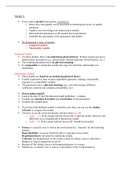Module 8:
If you want to predict food quality, you have to:
o Know how food quality can be described in technological terms via quality
attributes.
o Capture your knowledge into mathematical models.
o Determine the parameters in the models from experiments.
o Establish the uncertainty in the parameters and models.
We distinguish 2 types of models:
o Empirical models.
o Mechanistic models.
Empirical models:
For these models, there is no underlying physical theory these models just give a
mathematical description (e.g., polynomials, rational functions, formal kinetics, etc.).
The resulting parameters have no physical meaning.
It is impossible to extrapolate outside the range for which the relationship was
established.
Mechanistic models:
These models are based on an underlying physical theory.
Usually expressed as time or space dependent equations, relating a measurable
response to a controllable variable.
The parameters have a physical meaning (e.g., activation energy, diffusion
coefficient, reaction rate constant, permeability, etc.).
How to judge a model?
1. Look at the data plot the data and model prediction + compare.
2. Evaluate the standard deviations and correlations of the parameters.
3. Evaluate the residual plots.
If you have built different models to describe your data, you can use the Akaike
criterion to compare the models.
You have to use the corrected Akaike criterion when n/p <40.
o AIC > 2-3 the model with the lowest AIC is the best model. However, the
difference is too insignificant to discard any model.
o AIC > 10 the model with the lowest AIC should be discarded.
Science is a specific way to look at the world around us. ‘Specific’ for the following
reasons:
- Reproducibility: everyone should be able to reproduce your results.
- Hypothesis/theory: presented to explain the results.
- Criticism: the interpretation of the results is open for debate, and it is allowed to
disagree as long as arguments are given.
Because of this debate, there is development/progress in science.
Models are a scientific way to convey a description of the world around us.
, o The danger is that we come to the wrong conclusions, because we do not have
a complete view of the system i.e., we have not incorporated all existing
information that may affect the data.
Statistics forms an indispensable part of science. Statistics helps in:
o Interpreting data separate the noise from relevant information. Note that
measurements always contain noise.
o Designing experiments how to obtain the most out of data with the least
possible effort.
o Model building adds the stochastic part.
o Making realistic predictions by making variation explicit.
Benefits of modeling:
(+) Gives insights into what is happening, aids in scientific understanding, serves as a
tool for research.
(+) Aids in predicting product properties, forming what-if analyses.
(+) Useful for product and process design demands on food supply change so
rapidly that it is impossible to study everything experimentally.
(+) Aids in controlling food quality and food safety in an efficient way.
Models in food science literature are often empirical and not very quantitative. These
models are also not that innovative poor use of the available computing power.
The limitations and possibilities for kinetic modeling are not very clearly stated.
Statistics is not always used properly in food science literature, if used at all!
Note that there is a big difference between models and the truth models only exist
in our mind, not in nature. Models are solely an approximation of reality. You learn
about reality by:
o Doing experiments.
o Making observations.
We do not model collected data, but rather the information contained within these
data. Models are thus a summary of information represented by data they give a
grip on reality.
In the plot on the right, you see the blue line that
represents reality. Three different models are built
to capture this reality.
However, the problem is that we do not know this
blue line (reality). If we did, why would we even
need models?
‘Something’ in reality causes the data we observe.
This is where science comes in we try to model
this ‘something’ in reality in terms of chemistry,
physics, etc.
We can thus propose models, based on scientific insights.
There are always more models feasible for a certain problem.
Models must be confronted with reality (i.e., data).




